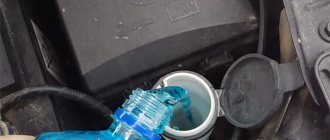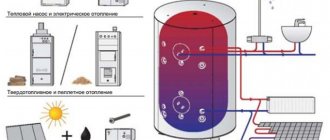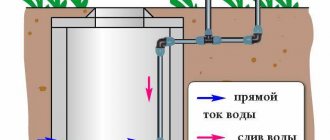Features of winter operation of a split system
As already mentioned, the minimum operating temperature of a split system during winter operation is indicated in the instructions for specific equipment:
- most non-inverter split systems are designed to operate down to -5 degrees, some models up to +5;
- most inverter units are designed for operation at -10 - -15 degrees;
- Some heat pump models from leading manufacturers are designed for heating at outside temperatures down to -28 and colder.
The efficiency of a split system is highly dependent on the outside temperature. At temperatures around zero, almost any air conditioner can produce several times more heat than the electricity used.
How to use air conditioning in winter
To determine at what temperature the air conditioner cannot be turned on in winter and when it can be used, you must carefully read the instructions for the specific model. The manufacturer clearly indicates everything there; going beyond the established temperature parameters is highly not recommended. The same applies to the heating mode. There is technology that can heat the air, and there is one that works exclusively for cooling.
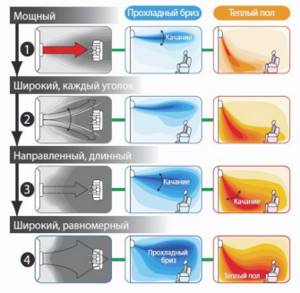
Temperature distribution when the air conditioner operates in different modes
In winter, it is quite possible to use the air conditioner in all permitted operating modes, just like the same ventilation in the garage. However, you should make sure that its drainage does not freeze, and that the external block is secured to the wall taking into account the formation of an additional ice crust on it.
Possible breakdowns of split systems in winter
Every user should know that it is necessary to use a split system for heating according to the instructions; The main reasons for frequent breakdowns are improper use of the air conditioner and non-compliance with the temperature regime in winter. Situations often arise when, after pressing the necessary buttons and selecting the desired mode, the heat does not flow. There can be many reasons for this and they definitely need to be checked. The following phenomena are not uncommon:
- The batteries in the control panel do not work;
- the sensor does not respond well to the device;
- there are violations in the operation of software;
- severe damage to the air conditioner.
The most common cause of device failure is a malfunction of the batteries in the remote control, so many people think that they were given a defective device. Solving the problem is very simple, just change them for new ones and start the device again.
If the problem lies in a sensor malfunction, then in this case you will not be able to solve it yourself. It is best to return the device under warranty or call a repairman. If the air conditioner's warranty is still valid, then the air conditioner must be replaced with a new one or the sensor equipment must be replaced.
All this makes it clear that there are problems that urgently need to be solved before the device breaks down completely. Therefore, it is better not to try to repair the device yourself, but to contact a service center.
When the equipment completely stops working, if it was used for other purposes or was frequently rebooted, repairs for such problems will be expensive, and it is better to think about buying a new air conditioner.
Winter air conditioner kit
Recently, more and more often you can find proposals for equipping an air conditioner with a winter kit. Sellers of this equipment assure that its installation will make the air conditioner an effective heater throughout the winter, even in frosty weather. Whether this is so - we will figure it out.
Components of a winter work kit
A low-temperature kit, as a rule, includes 3 components: a heating pan, a compressor crankcase and a fan speed controller. Sometimes there is also a temperature sensor and a control board - separate for each component or common to all.
Heating the pan is necessary to prevent the condensate draining from the radiator from freezing when the defrost mode is turned on.
The crankcase heater is a wire or plate that surrounds the compressor in the place where oil accumulates.
It is advisable to turn on the compressor heating before starting the air conditioner so that the oil has time to warm up. In practice, heating often occurs either only during operation or only during idle time. Only the second option will ensure safety for the compressor, but it is less profitable due to increased energy consumption.
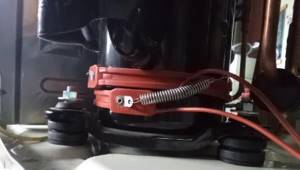
Thanks to crankcase heating, you can avoid cold starts and operation of the compressor when the lubricant has thickened in the cold, which means increased load during startup and wear of moving parts
Adjusting the fan speed determines the activity of heat exchange between freon and the external environment: the stronger the air flow, the more heat is transferred. When working for heating, this is not critically important, because maximum heat transfer is needed, and high fan speed is set from the factory.
It’s another matter if the air conditioner operates for cooling at temperatures below +14 – +180 allowed by the manufacturer. Then the freon can give off too much heat, and the indoor unit will begin to freeze: it will become covered with frost and ice, and the condensate will freeze. To prevent this from happening, the fan is slowed down.
Is it advisable to install a winter kit?
After installing a low-temperature kit, the owner may have a question: is it now possible to heat the room with an air conditioner at low outside temperatures? The answer is yes, you can, it is now safe for the air conditioner. The exception is unqualified installation or home-made equipment.
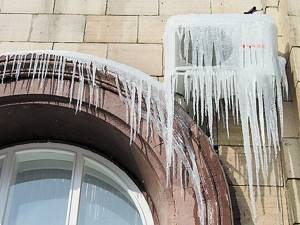
If there is dripping from the roof on the air conditioner and therefore huge icicles form, a winter kit will not help - you need a protective visor
Is it effective? Air conditioning heating is valued for its efficiency: its efficiency can reach 3 – 5 and even 7, depending on the model. This is achieved by the fact that the split system is the only heater that does not produce heat. The compressor and fans require much less energy to operate than the system can move into the home.
The declared efficiency, or, as the manufacturers write, COP, is relevant when operating for heating at +70 outside. As it gets colder, the temperature difference between air and freon decreases, which means heat exchange worsens and the efficiency of the air conditioner decreases.
At temperatures below -150C, the efficiency of the air conditioner decreases to approximately 1%, that is, for every kilowatt of electricity consumed, only 1 kW of heat can be obtained. Conventional convectors or infrared heaters, which are cheaper and do not depend on the outside temperature, also have such indicators.
Of course, these calculations are approximate; the result greatly depends on the model of the air conditioner, the low-temperature set, and even the connection diagram of the second one. But the fact is that the lower the temperature outside, the less effective and economical heating with a split system is.
Considering that the cost of a good winter kit for turning on heating with an air conditioner with installation can be 40 - 150% of the cost of the air conditioner, and it will work effectively only down to -150C, the feasibility of the purchase is very controversial.
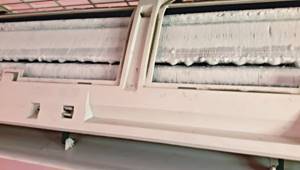
When the air conditioner operates for cooling in winter without a low-temperature set, frost and an ice crust forms on the indoor unit
It's another matter if you need to cool the room in winter. For example, for a room with equipment. Then the lower limit of permissible temperatures drops from +16 declared by the manufacturer to severe frosts, and the efficiency of the air conditioner will not decrease.
Installation and connection of the winter kit
As we already mentioned, professional installation of a low-temperature kit is not cheap. Not every owner of a split system is ready to pay 5,000 rubles or more for the opportunity to turn on the air conditioner for heating at a temperature 10 - 15 degrees lower than stated. If you're not prepared for that kind of expense, you might be interested in installing a winter kit yourself.
Let us remind you that to operate in winter, the air conditioner requires heating of the sump, the compressor crankcase and the RDK unit - a condensation pressure regulator that controls the fan speed. You can buy a ready-made kit and install it yourself.
Then you will be freed from the difficulties of choosing and searching for components, and will also save money on installation, but you will probably lose the warranty on the split system. Naturally, self-installation means additional hassle.
The most economical option is to buy 2 pieces of heating cable, preferably self-regulating, and connect them yourself. Controlling the fan speed when working for heating can be neglected; we explained why above.
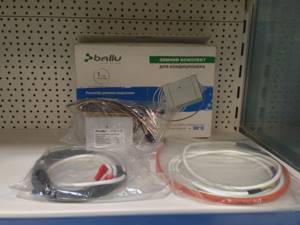
When choosing a low-temperature kit, pay attention to what power air conditioners it is intended for. There are 2 types of sets, up to 12 BTU and for more powerful systems
To heat the tray, you will need a piece of heating cable about 3 m long. They lay it around the radiator both from the outside and from the inside, as well as along the entire tray in a snake. You can connect the power supply to the outdoor unit, like the factory heating, to the main phase - then the cable will always heat as long as the air conditioner is plugged in, even when idle.
Alternative options are to bring a separate cable with a plug to the outlet and turn it on manually, connect it to the network through a thermostat on the street or through a timer.
To warm up the oil in the compressor, wrap a piece of heating cable around it at the bottom. The electrical connection is carried out together with the heating of the pan.
If you purchased an RDK, you need to find a free space for it in the control compartment, above the compressor, and secure it with self-tapping screws. The electrical connection differs for different models and is always described in detail in the instructions. For correct operation, the sensor included in the kit is attached to the middle loop of the radiator, coated with thermal paste, and wrapped with heat-insulating material.
Turn on the “AUTO” function: step-by-step instructions
Despite the fact that this function has a complex technical meaning and independently “selects” the necessary actions, its purpose is to facilitate the operation of the split system. It turns on very simply:
- We connect the equipment to the network, i.e. Insert the cord and plug into the outlet. A characteristic signal may sound and the device’s blinds should return to their initial position;
- Using the remote control, press the “ON/OFF” button;
- Then press the “Mode” button several times so that the word “Auto” or the automatic mode indicator lights up on the remote control (can be indicated as a triangle, in the form of various circular arrows or the letter “A”). Each press of the button “responds” with a sound signal.
- Some models suggest the ability to change the temperature for the specified mode. We change it using the “+”/“-” keys, respectively increasing or decreasing the required temperature.
Important!
Some air conditioner models can start immediately after plugging the plug into the socket. In this case, skip the second step (do not press the “ON/OFF” button). The fan speed is also displayed on the remote control of all air conditioners. This fan can have automatic speed. Those. “auto” may appear on the display, which refers specifically to the fan speed, and not to the “auto” mode
It is important to distinguish these two settings!
How to turn the air conditioner on warm
To switch the heating mode, use the control panel. After turning on the option, you should not expect an immediate flow of warm air. It will arrive in the room in 10-15 minutes.
Turning on the air conditioner for heating (step by step instructions):
- On the control panel press the “ON” button.
- To turn on the heating mode, use the MODE button, then HEAT. On some remote controls this button is marked with a “sun” symbol.
- Using the +\– buttons, the user can set the required temperature value.
- After setting the temperature, the device is activated in operating mode. The fan will start and within a few minutes warm air will begin to flow into the room.
In some models of split systems, the heating mode is turned on in the reverse order: first the user sets the temperature, and then presses the button to start the operating mode. The attached instructions contain precise information on how to turn the air conditioner on warm.
Operate air conditioners in winter according to the rules recommended by the manufacturer, and be sure to check the air temperature outside, focusing on the permissible temperature range parameter, before turning on the air conditioner for heating. This will allow you to effectively operate climate control equipment during the winter season, eliminating the risk of its rapid failure.
Consequences of operating the system at prohibited temperatures
If, when operating climate control equipment, you ignore the manufacturer’s recommendations on the maximum permissible temperature values, critical breakdowns are possible.
Why it is impossible to use systems that are not intended for operation in winter is additionally indicated by the manufacturer in the precautionary measures. Here's what happens if you don't follow the restrictions:
- reduction in the efficiency of equipment up to shutdown;
- icing of the external and internal units;
- thickening of oil in the refrigerant;
- excessive friction of parts without lubrication;
- the appearance of ice in the drainage tube;
- leakage of condensate into the living space;
- broken fan blades;
- Compressor wear and breakdown.
Turning on the air conditioner in winter for cooling
Considering the fact that most air conditioners operate on a similar principle, it is prohibited to use climate control equipment for cold temperatures at low temperatures. Thus, you can turn on cooling in winter only if the temperature corresponds to the range established by the manufacturer. In most cases it is not lower than -5 degrees.
If cooling is required at sub-zero temperatures below 5 degrees, for example, for server rooms, a special system is needed . Otherwise, the air conditioner will fail - the compressor will simply overheat and burn out. Specific information should be clarified directly in the instructions for use of the individual device.
Ventilation of the room with air conditioning
There is one more important thing to consider. The air conditioner does not interact with the air outside in any way. It circulates the same air around the room, and the external installation is only responsible for removing excess heat from the room.
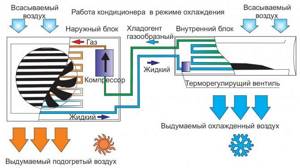
Only refrigerant moves between the indoor and outdoor units of the air conditioner, usually freon. It removes excess heat from the room, but does not renew the air
Air exchange is also important to maintain comfortable indoor conditions. And if you do not ventilate the room for a long time, the oxygen level will decrease and the level of carbon dioxide will increase. Of course, this is not fatal, but the lack of oxygen can make you feel tired and drowsy.
Before ventilating the room, be sure to turn off the air conditioner. Open windows and, if possible, doors. This creates a draft, but allows the air to renew itself very quickly. It is advisable that at this moment there is no one in the room, especially children. If there is no way to vacate the room, then it is better to limit yourself to windows only.
We said above that when the air conditioner is on, it is necessary to close the windows, and when ventilating, turn off the air conditioner. Let's figure out why this needs to be done.
Modern air conditioners do not blow at the set power all the time. They cool the room to a set temperature, after which they begin to work to maintain it. This allows you to wear out the equipment and filters less quickly and save energy.
If you open the windows when the air conditioner is on, active air exchange will begin to occur in the room. Hot air from the street will replace the cooled air in the room. In this case, the air conditioner will work at full capacity, actually cooling the street.
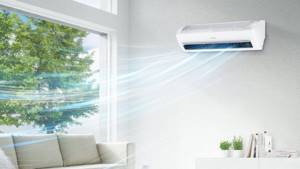
Powerful models may be able to maintain the set temperature even with the windows open, but this will lead to rapid wear and tear.
If you forget about it once, then nothing bad will happen. However, repeating this on a regular basis, there is a high chance of being left without air conditioning and with a huge electricity bill.
We also recommend reading our other article, where we described in detail the principle of operation of the air conditioner.
Possible problems
When your air conditioner is running for heating in the winter, it is at greater risk of breakdown than in the summer. Therefore, it is worth monitoring its work more carefully. If suddenly the air conditioner stops turning on for heating or produces less heat, you need to pay attention to this. Check the following:
Does the compressor run when the air conditioner is turned on? If not, try warming it up with a regular hair dryer. It may not turn on for the following reasons:
- Due to the low temperature, the oil became too viscous;
- There is an oil leak (check the bottom of the compressor for leaks);
- The compressor has failed.
Sometimes the air conditioner starts to work worse for heating. than usual. In this case, please note the following:
- Is the fan working? If not, warm up its bearing with a hairdryer. But it's better to replace it;
- The condenser radiator in the outdoor unit or the grille in front of the fan may have iced up. If so, melt the ice with hot water;
- Freon leak. It is impossible to determine such a problem on your own. If none of the above helped you, contact a specialist .
Important information about temperature limits
For the cold season there are important restrictions. You cannot turn on the heating when the outside temperature is below 0 C°, otherwise the following problems will begin:
- the condensate on the external heat exchanger begins to freeze, so the outdoor unit begins to become covered with ice;
- as a result, heat transfer deteriorates;
- heating performance decreases.
At what temperature exactly can you turn on the air conditioner for cooling? It is important to ensure that it does not fall below +5 C°. If it is violated, the following may happen:
- the performance of climate control equipment will decrease;
- freezing will occur in the structure of the street block and drainage pipe;
- The compressor may break down during startup.
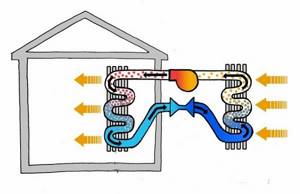
Air conditioner operating diagram
At what temperature can and cannot be turned on?
The best option would be to use an air conditioner during the winter season at temperatures from 3 to 10 degrees.
In this case, the device will be able to show maximum performance when consuming 3 kilowatts of electricity (approximate number). If the outside temperature drops below 0, equipment performance drops. The compressor wears out and air begins to be pumped incorrectly. However, all devices have their own permissible technical temperature limits when they can be used. For example, the instructions may indicate that compressor wear will occur at a temperature of -15 degrees. It will be possible to turn on the device when the reading is not lower than -12 degrees. This point should be understood when purchasing a foreign or Russian-made device for your home.
Why is it important to observe the temperature difference?
Modern climate control equipment works wonders. Outside the window it may be incredibly hot at 40 degrees, but indoors the air conditioner can maintain a comfortable coolness of 20 degrees.
But it is worth considering that sudden temperature changes of more than 7 degrees can cause ARVI with further exacerbations, even pneumonia. If you walk from a hot street into a cool room with air conditioning, you will feel comfortable. However, the risk of getting sick will increase several times.
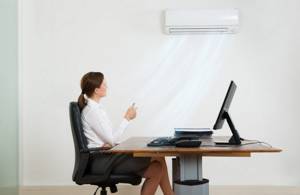
If you stay indoors all day, maintaining the temperature difference can be neglected. But being under a cold stream all the time is not recommended.
Therefore, it is necessary to set the temperature of the air conditioner in rooms where people often enter and exit, taking into account the above difference.
If we are talking about office space, then failure to comply with this simple rule can lead to all employees going on sick leave.
Air conditioner performance
Many people mistakenly believe that at a minimum temperature, an air conditioner can effectively heat a room. If you are one of them, you are mistaken. The performance of the air conditioner depends on the power of the compressor.
Typically, the manufacturer specifies the minimum operating temperature for the air conditioner at which it can maintain +20 degrees in the room. And if you want to warm up a cold room, it will take a lot of time.
The performance of the air conditioner drops along with the outside temperature. The colder it is outside, the less heat it can give off (see graph). It is designed for heat pumps, but clearly illustrates the performance and efficiency of air conditioners.

Graph of the performance of Toshiba air conditioners depending on temperature.
Split system temperature sensors
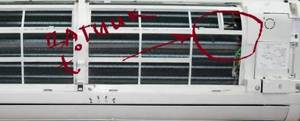
temperature sensor in the indoor unit
It was already mentioned above that air conditioners are equipped with special temperature sensors that monitor both street and room indicators, as well as values inside the device itself.
Modern split systems have a developed self-diagnosis system, the elements of which are temperature sensors. The main ones among them are two sensors: air temperature sensors and indoor unit evaporator sensors. They determine the operating algorithm depending on the selected mode. Air conditioners are equipped with these temperature sensors in the simplest configuration.
More expensive systems are equipped with the following types of temperature sensors:
- outside air temperature sensor – does not allow the air conditioner to turn on at sub-zero and plus temperatures, which are below/above the permissible norm;
- condenser temperature sensor (there may be several of them) – is responsible for maintaining the required level of condensation pressure for a given mode when street conditions change;
- room air temperature sensor – responsible for maintaining the functionality of the compressor;
- Evaporator temperature sensor – turns off the compressor if the temperature of the air conditioner evaporator drops to zero.
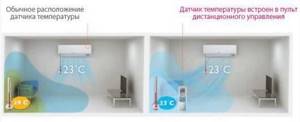
Temperature sensor in the remote control
Some split systems have an additional function - automatic defrosting of the heat exchanger of the external unit. This is necessary to prevent icing processes that cause the fan blades to break. The defrosting mode of the air conditioner is activated at sub-zero outside temperatures. Thermal sensors are also responsible for this.
Another function of modern split systems is the automatic selection of a mode, which, when started, sets a “comfortable” temperature at +20°C. Sensors are also responsible for the proper operation of automatic installation of standard indicators.
If we talk about the temperature of the air conditioner evaporator, then there is a direct dependence on external factors - the higher the thermometer readings outside the room, the more intensely the evaporator heats up.
For all-season splits, when the compressor is turned on, the difference between the temperatures of the air and the air conditioner evaporator should be at least 5-7°C. When the compressor is turned off, these indicators change towards lower values. When a decrease does not occur, this indicates a system malfunction.
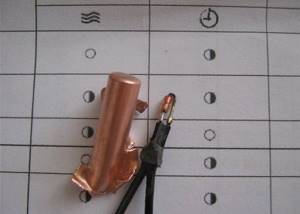
Evaporator temperature sensor
When operating the device for heating, the air parameters in the room are also taken into account. If the air conditioner temperature sensor responsible for room data shows a difference between the outside and indoor temperatures of less than 5°C, the compressor may automatically shut off or it may not start initially.
When the air conditioner is operating for cooling, the temperature at the outlet of the indoor unit should be at least 10°C below the thermometer outside. It is worth remembering that when starting a split system, these values may not be reached immediately, so cooling occurs less intensively.
The longer the air conditioner is on, the more optimally it cools.
Air conditioning heating in winter: pros and cons
An air conditioner is a special household appliance designed to cool air. Manufacturers of climate control equipment equip modern split systems with a heating function, which allows the owner to operate the air conditioner not only in summer, but also in the cold season, creating a warm, comfortable atmosphere in the room. Thanks to the built-in settings system, the user can set the required air temperature in the room.
The heating option is an undeniable plus of climate systems. But there are also disadvantages.
Features and disadvantages of heating with air conditioning:
- An air conditioner is not a full-fledged heating device, so many manufacturers recommend using them as an additional heat source or for heating rooms in the off-season, when the central heating system is not yet operating. But if you choose an air conditioner with sufficient power for the heated area of the room, such a device will completely replace conventional radiators.
- Split systems cannot be used for heating if the outside temperature is below the critical temperature indicated in the user manual. As a rule, the maximum value of many models is –100, –150. Thus, for many northern regions of Russia, cold winter weather becomes a serious obstacle to the operation of climate control equipment for heating. The only way out is to purchase a special winter kit for connecting to an air conditioner, which allows you to operate the equipment at high sub-zero temperatures.
- In the southern regions, where the air temperature in winter rarely drops below -100, such a device can become a full-fledged source of heat, taking into account the correctly selected power.
- The air conditioner operates from the mains and uses a certain amount of energy during its operation. During the winter season, the device operates at high power and consumes more energy. The owner is advised to calculate in advance how profitable it will be for him to operate the air conditioner for heating, or whether it is cheaper to heat with convectors or other types of heaters in the winter season.
Preparing your air conditioner for winter
In many climate control companies, closer to the cold season, there are many requests for preparing the air conditioner for winter. What is it and can you make it yourself?
Insulating the air conditioner for the winter
What is insulating an air conditioner for the winter and how is it done? The outdoor unit can be wrapped in thick cellophane film, the indoor unit is either also covered with polyethylene, or the hole from the drainage drain is plugged.
There is no other way to insulate the air conditioner for the winter if we are talking about a split system. As already mentioned, for a mobile unit you simply close the plug on the street side, and for a window unit, it is advisable to cover the part of the device protruding outward with a film or warm material. Sometimes window monoblocks have to be dismantled for the autumn-winter period, since they can serve as conductors for cold air to enter the apartment.
Self-preparing your air conditioner for winter
It turns out that you can prepare your home air conditioner for winter yourself, but how to do it correctly?
- First, turn on the split system for a couple of hours in fan mode, and then for an hour in heating mode. This will help thoroughly dry all the internal components of the device;
- Wipe off dust from the outer surfaces of the device with a soft, slightly damp cloth. Professionals usually use microfiber for this;
- Wash the mechanical filters in the indoor unit;
- Completely de-energize the system;
- Remove the batteries from the remote control.
There is no need to take any further additional actions on how to prepare your air conditioner for winter. The only thing is that those who have a split system on the windy side may want to think about insulating the refrigeration machine.
Professional preservation of air conditioner for winter
Professional services for preparing (preserving) an air conditioner for winter usually include the following list of works:
- pumping freon into the outdoor unit;
- complete de-energization of the system to avoid accidental switching on;
- installation of protection for the external unit from falling icicles in the form of a special iron visor;
- cleaning the indoor unit.
Although the entire list of listed services is not always required. It is better to carry out a thorough cleaning of the indoor module with washing of the filters, heat exchanger and fan before the start of the warm season, and before the cold weather it is enough to rinse the mechanical cleaning filters in a soapy solution. Freon pumping can be eliminated altogether. As practice shows, it survives well until spring without unnecessary manipulation. Professional preparation of the air conditioner for winter or its preservation is justified in the case of commercial or industrial equipment. In this case, service departments may refuse warranty repairs if the device was not sealed before the cold weather. In order to reactivate the equipment, you will have to contact the climate control company again.
The principle of operation of an air conditioner for heating
When you turn on the air conditioner in heating mode, the refrigerant changes from a liquid state to a gaseous state and evaporates, partially taking away the heat. The compressor transfers the gas refrigerant to the internal block of the split system, and all the heat accumulated along the way is released in the evaporator. Warm air enters the room, raising the temperature.
Efficiency and heating efficiency of air conditioning
Efficiency is the efficiency factor expressed as a percentage.
In the split system passport you can see the efficiency, EER and COP indicators, where EER determines the cooling efficiency, and COP is the average indicator of cooling and heating efficiency. As a rule, EER is always less than COP, since during operation the compressor generates heat and warms the freon. Using these parameters, you can determine the efficiency of heating.
For example, the product data sheet contains the following data: COP – 2.6; EER – 2.4; Efficiency – 260%. These parameters indicate that when consuming 1 kW of energy, the air conditioner will produce 2.4 kW of cold and 2.6 kW of heat. However, these values also depend on the difference in temperature between indoors and outdoors. The greater the difference, the lower these indicators, so the colder it is outside, the worse the efficiency of the air conditioner for heating.
How to increase the efficiency of an air conditioner for heating:
- Make sure there is no ice on the outdoor unit.
- Connect a special winter kit to the split system.
- Carry out preventive cleaning of the units from dust and other contaminants that impair the operation of the device.
- If the weather outside is too cold, use other heat sources for heating.
- When installing the outdoor unit of a split system, try to choose a place protected from wind and moisture.
Summer work
Any air conditioner with a cooling mode does not have a heating element. There is a valve inside the outdoor unit that helps the refrigerant circulate. The evaporator and condensate change places, and the heat exchanger of the indoor module receives the heat of the freon and cools it. The propeller forces air through the condenser and heats the air flow. The freon arrives to the outdoor unit already cold. There it takes heat from the room and releases cold.
The air conditioner does not heat the air inside, but simply circulates it. This plan is effective when the temperature outside is above zero. If the outside temperature is below 0°C, the air conditioner may not cope with the task, so it is better to purchase a more powerful model. It will warm the room even in severe frosts.
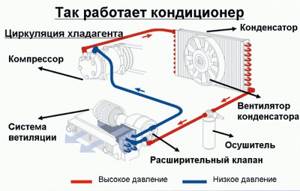
This is how an air conditioner works
Choosing a split system with heating function
When choosing a heated air conditioner, you must consider the following parameters:
- power consumption of electricity;
- thermal energy productivity;
- energy efficiency category;
- range of permissible operating temperatures;
- automatic defrosting mode of the condenser in the outdoor module.
There are also several other aspects that should be kept in mind when operating an inexpensive air conditioner in heating mode: the purpose of the room (residential, industrial); room dimensions. For example, if this is a production workshop in which there are a large number of workers, then much less energy consumption will be spent on heating. Consequently, the efficiency will be close to the best value.
If you need to choose a split without built-in heating, then it is better to choose inverter air conditioners with winter components, since they are designed to operate in an extended range of sub-zero temperatures.
Nuances of operation
Modern models of air conditioners are quite complex household appliances, the setup of which requires compliance with basic rules.
- It is necessary to clearly select the power of the product depending on the volume of the room: in regions with very hot climates it is necessary to install systems with higher power, with improved cooling characteristics.
- Always correlate the operating mode of the product with the weather conditions outside.
- In order to prevent the occurrence of any colds, it is necessary to fine-tune the equipment in cold mode.
- Carry out regular maintenance - these measures will allow you to ensure normal operation of the product and a safe and comfortable microclimate for the whole family.
- Installation, maintenance and repair of equipment should only be done by professionals.
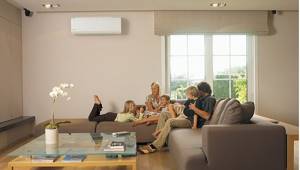
Climate systems can be installed in any premises, regardless of their configuration and dimensions, because modern technology copes with the task without any problems. The user must only follow all the rules and recommendations stated in this article.
Some myths about air conditioners
The first air conditioners, for example, Soviet BK and many other window models, were able to work exclusively for cooling. They hummed like transformer boxes, but supplied the apartments with life-saving coolness. Over time, traditional air conditioners were replaced by split systems consisting of two blocks. They are more convenient to install and have a lower noise level. In addition, they learned to work in two directions.
This is precisely what is associated with the myth that the air conditioner cools in the summer and heats in the winter. This is not true - without proper retrofitting (if it is provided at all by the manufacturer), it will not be able to work in the winter season. Heating is possible only in spring and autumn, when the outside air temperature has not yet dropped below zero. As soon as it crosses the zero mark, it cannot be turned on (or not recommended - it all depends on the model).
Another myth is that a split system takes in outside air, cools it and supplies it to the room. This is not true - the vast majority of air conditioners circulate the air in the rooms. The option to suck in outside air is present only in expensive models. Moreover, it is not very clear why such simple functionality has such an impact on the cost of equipment - it simply soars in price.
Preparing the device for winter
In order to prepare the split system or device for winter, it is necessary to pump the refrigerant into the external unit. Next, you will need to completely turn off the system so that it is not activated unintentionally. Next, special protective canopies are installed over the street block to prevent icicles from sticking and damaging the device. The internal mechanism is also cleaned.
You can prepare the device yourself as follows. First you need to activate the device for 2 hours to cool down. Then you need to work in heating mode. This makes it possible to completely dry all the internal elements of the equipment. Next you need to wipe off the dust from above. The filter must be washed and dirt and dust removed. The system must be completely unplugged and the batteries removed from the remote control so as not to be turned on accidentally.
If your system is located on the windy side, then you should try to insulate the block additionally. Many people simply wrap it in cellophane on the outside. Inside, they simply cover it with something.
If you don’t need air conditioning in winter, then you don’t need any additional care for it. Simply clean it, close it and turn off the power. Insulate if necessary.
If a split system can be used in winter, then it is necessary to wash the filters, fan and other elements where dirt and dust could accumulate. The regularity of such procedures may depend on the dustiness of the room itself. The number of people who are constantly in the room, as well as the number of furniture, carpets and other things, also affects. If there is not a lot of dust, then one procedure per season is enough.
To what temperature can an air conditioner cool?
The main function of an air conditioner is cooling. It is the only one provided only by this type of technology. You can heat, dry and filter the air using other units. But to what temperature does the air conditioner cool?
How does an air conditioner cool?
The cooling temperature of the air conditioner depends on the class of equipment and its price. But the cooling circuit is the same for all air conditioners. The cooling circuit of an air conditioner consists of a condenser, a compressor and a copper line. In the copper line, the refrigerant (freon) and some oil from the compressor constantly move in a circle.
From the evaporator, the refrigerant enters the compressor in the form of gas under reduced pressure (from 3 to 5 atmospheres) and at a temperature of 10 to 20 degrees. Here it is compressed to 20 - 25 atmospheres, which leads to an increase in the temperature of the refrigerant to 75 - 90 degrees. And in this form it is supplied to the capacitor.
Here, with the help of a fan, the temperature of the refrigerant decreases, it becomes liquid and gives off heat to the surrounding air. The freon pressure increases, and so does the temperature (by 15 - 20 degrees more than the surrounding air temperature). Hot freon is supplied to the thermostatic valve, where it is cooled.
In the valve (copper tube in the form of a spiral), the gaseous and liquid phases of the refrigerant are combined and supplied to the evaporator. Now the refrigerant takes heat from the air, becomes gaseous and is again supplied to the compressor. This cycle repeats itself over and over again. The cooling temperature of the air conditioner and the temperature of the air leaving the case vary significantly.
Possible breakdowns
Every user should know that it is necessary to use a split system for heating according to the instructions. The main reasons for frequent breakdowns are improper use of the device and non-compliance with temperature conditions. Situations often arise when, after pressing the necessary buttons and selecting the desired mode, the heat does not flow. There can be many reasons for this and they definitely need to be checked. The following phenomena are not uncommon:
- The batteries in the control panel do not work;
- the sensor does not respond well to the device;
- there are violations in the operation of software;
- severe damage to the air conditioner.
The most common cause of device failure is a malfunction of the batteries in the remote control, so many people think that they were given a defective device. Solving the problem is very simple, just change them for new ones and start the device again.
If the problem lies in a sensor malfunction, then in this case you will not be able to solve it yourself. It is best to return the device under warranty or call a repairman. If the air conditioner's warranty is still valid, then the air conditioner must be replaced with a new one or the sensor equipment must be replaced.
All this makes it clear that there are problems that urgently need to be solved before the device breaks down completely. Therefore, it is better not to try to repair the device yourself, but to contact a service center.
When the equipment completely stops working, if it was used for other purposes or was frequently rebooted, repairs for such problems will be expensive, and it is better to think about buying a new air conditioner.
Differences in the design of frost-resistant air conditioners
Why can one air conditioner be turned on at 30 degrees below zero, while it is undesirable to start others at -50C?
The answer is simple: structural features and configuration. The cost of a split system is not always directly proportional to its capabilities, and therefore it is useful to know what effective design solutions exist. To understand whether it is possible to turn on a particular air conditioner for heating in winter, or whether this is dangerous for the device, pay attention to such details. Firstly, a low temperature kit must be built in from the factory to prevent cold starts of the compressor and condensate freezing
Firstly, a low temperature kit should be built in from the factory to prevent cold starts of the compressor and condensate freezing.
As we have already mentioned, inverter models are preferable in winter, since their compressor does not stop when the set temperature in the room is reached, but only slows down. This means that it will not cool down every time and start up with an overload, and it is also more profitable in terms of energy consumption.
The heat exchanger of the outdoor unit can be enlarged so that the freon inside has time to completely evaporate and absorb maximum heat from the air before entering the compressor.

The large area of the heat exchanger allows the split system to operate efficiently even with a small difference between the boiling temperatures of the refrigerant and the air outside
There are also double-circuit heat exchangers in which the performance is regulated by connecting an additional freon circulation circuit. The external unit and heat exchanger may include additional casings and heat accumulators to use the energy generated by the operating equipment.
A high-power compressor compresses the gas more strongly, heating it to higher temperatures. In industrial models, there are also scroll compressors that are not afraid of the ingress of liquid freon.
The refrigerant itself may have different properties. Cheap and widespread R-22 evaporates at -400C, while being able to absorb heat of 233 kJ/kg. For comparison, the newest R-32 evaporates at -51.70C, and is capable of retaining heat up to 390 kJ/kg.
This means that under the same conditions, the second one will heat up faster and more efficiently in the heat exchanger, and the air conditioner or split system will operate with lower energy consumption and higher efficiency.
The type of oil that lubricates the compressor also depends on the type of refrigerant. R-22 works with mineral oil, which maintains an acceptable viscosity down to -50C, and R410A and R32 - with synthetic oil, which is stable down to -70C. It would seem that the difference is small, but taken together with other factors it is significant.

Mitsubishi Zubadan is the most famous series of heat pumps that operate in winter at temperatures down to -250C. They cost 3–5 times more than split systems, which can heat only in slight frosts
The more of the listed upgrades the air conditioner has, the lower the temperature it can operate at. However, for many inverter models you may not even know the maximum permissible temperature: the electronic control simply will not start the system if it is too cold outside.
What is the air conditioner temperature in summer?
In most cases, when the weather is hot outside, the room temperature should be 24-25 degrees. But if the outside temperature is 35 degrees, then first it is better to set the temperature to 30 degrees, and after 20 minutes you can reduce it to the desired one.
For offices, classrooms and other premises where work is performed primarily in a sitting position, the air temperature in the warm season should be 23-25 C, but fluctuations within 18-28 C are allowed.
There are times when a person cannot set the temperature in the air conditioner himself; in this case, you need to linger a little in the hall or dressing room; in these rooms there is not such a sharp temperature difference. Only after being there for about 3-5 minutes can you enter a cooler room.
If the temperature difference is more than 5 degrees, there is a risk of a sharp redistribution of blood in the body, and this can be a serious blow for people who have problems with the cardiovascular system. Moreover, this applies not only when a person goes from hot to cold, but also vice versa, from cold to warm.
The optimal air temperature in gyms and other sports facilities located indoors is 17-19 degrees C +/- 2 degrees in winter and 18-28 C in summer. For sports such as hockey or curling, the room temperature is much lower.
Problems and solutions
Possible problems that may arise when operating the air conditioner at sub-zero temperatures:
- Freezing of water in the drainage pipe;
- Icing of the outdoor unit;
- Temperature too low;
- Increasing the viscosity of the oil in the pan;
- Freezing of fan bearings.
If in winter your air conditioner starts spitting water or condensation starts dripping from it, the problem is in the drainage. An ice tube may form in the drain tube and moisture will not drain out. The problem can be easily solved - warm up the outer part of the drainage tube.
If the efficiency of the split system has dropped, or it has stopped cooling altogether, you need to follow these steps:
Just look at the thermometer. If the temperature outside is below the minimum specified in the instructions, there is nothing to do. You'll have to wait for warmer weather or install a winter kit (discussed below).
Check whether the outdoor unit is covered with ice. In particular, the radiator (condenser). It is located on the back side of the outdoor unit. If it is frozen, rinse it with warm water and dry it, or better yet, dry it with a hair dryer.

Icy outdoor unit. It will not be able to give the air conditioner full power and may cause it to break down.
Sometimes the grease in the radiator bearing freezes or it becomes covered with ice. If the fan does not rotate, try spinning it manually. If this does not help, warm up the bearing with a hairdryer.
Sometimes the oil in the compressor sump becomes too viscous. This can happen for three reasons:
- The temperature outside is too low;
- During maintenance or repair, the compressor was filled with inappropriate oil;
- The air conditioner was turned off for a long time.
In this case, you will need to remove the housing of the outdoor unit and warm up the lower part of the compressor. To do this, use a hair dryer.
Main problems
If you accidentally or intentionally turn on a regular air conditioner in severe frost, this can lead to big problems. The complexity of the breakdown depends on the mode of use and on what temperature was outside at the time of switching on. If you turn on the device for heating the apartment when it is -5 ° C outside, the outdoor unit will begin to become covered with ice, as it will release condensation. Heat transfer will deteriorate and heat output will decrease. Refrigerant may enter the compressor and damage the unit.
The compressor's performance will drop, leading to serious damage.
Exploitation
The main thing is to clean the split system before the cold season. Particular attention should be paid to the outdoor unit - because it is affected by frost and cold. If you wish, you can do it yourself. Read more in the article “How to clean an air conditioner yourself.”
There is no big difference between operating an air conditioner in winter and summer. You just need to turn it on and monitor the condition of the outdoor unit. It freezes up over time, causing the air conditioner's performance to deteriorate.
Many models have a defrost mode. If it does not turn on automatically for you, you will have to do it manually. when there is no such mode, you will need to chip off the ice and spill the outdoor unit with warm water.
It would be a good idea to install a canopy over the outdoor unit. In the spring, water will fall from the icicles onto the block, where it will freeze. This will cause it to freeze.
Important!
If the temperature “overboard” is too low, you cannot turn off the air conditioning. Otherwise, the oil in the compressor pan will become too viscous and you will not be able to start it
Cleaning the air conditioner
The instructions for the air conditioner provide for proper care. Especially if the device is active and works regularly. The split system must be cleaned periodically to maintain vacuum.
It is recommended to clean filters twice a month
Cleaning the indoor unit.
- Remove the cover and remove the filters. Wash them in warm water with a non-aggressive detergent.
- Carefully remove the rotor fan and wipe the blades with a damp cloth.
- Carefully clean the heat exchanger using a vacuum cleaner. For hard-to-reach places, use a thin brush.
- After the components have completely dried, install them in place.
If there is rust on the body, you need to call a specialist. Possible freon leak.
Cleaning the outdoor unit
- Remove branches, leaves and large debris from the grille and fan blades.
- Remove the cover. Clean surfaces with a cloth or vacuum cleaner. Be careful not to let water come into contact with electrical parts.
- Wash the radiator plates using high water pressure: shower, hose, car washer.
- Reinstall all parts.
The external unit does not need to be cleaned as often as the internal one
However, it is important to remove large debris in a timely manner so that the device does not overheat
Winter start of the air conditioner
Now there are split systems on sale that work normally at low temperatures outside the window. Most models are made in Japan for Norwegian or Canadian conditions. Such devices have an increased size of the heat exchanger, a heated outdoor unit, and special firmware for the compressor.
These are systems manufactured by Daikin, Toshiba, Mitsubishi and other brands. They can work to cool and heat a room when the temperature outside the window is down to -25˚. They are even used for hot water supply. And the price for such systems is very high.
But a regular air conditioner can also be adapted for this, you just need to install a winter starter on it. Without it, the device will lose more than 50% of its performance, and the compressor will overheat.
The winter start device consists of several important parts:
The crankcase heating block is the most necessary part for the device to work properly in the cold. When the air conditioner is turned off, refrigerant accumulates in the coldest places - in the outdoor unit. The next time you turn it on, it boils and can get into the compressor. This will lead to water hammer and failure.
Heating is also necessary to reduce the viscosity of the oil. Heating the drainage tube is important so that the fluid in it does not freeze and clog the hole. When the air conditioner operates in any mode, condensation is sure to form, which must be discharged outside
If the drainage tube becomes clogged, this liquid will flow into the room. A condensing pressure control unit is required to avoid pressure drop and loss of performance. This part will help avoid freezing of the outdoor unit and rapid wear of the system. This is achieved by reducing the air flow through the condenser. This regulator is installed on the outdoor unit.
After installation, the system must be checked. The air conditioner is turned on for cooling and heating for 3-4 minutes. It should blow air 10˚ more or less than the room temperature.
Modern split systems can operate on heat. But at the same time, the air temperature outside should not be lower than -5-10°. The lower the temperature, the lower the performance of the device will be.
Most often this function is used in urban environments. It is best to use such a device for heating a room in the off-season, when the heating has not yet been turned on or has already been turned off, and it is cold outside.
People often wonder whether it is necessary to cover the outdoor unit in winter. If a winter kit is installed, it must include heating using a ribbon cable. And without it, the device cannot be started at low temperatures.
When ice forms on the block, the fan blades will touch it and they may jam. The unit cannot be closed during operation. If the air conditioner does not turn on, then there is no need to wonder whether it is necessary to install an SPD or insulate the parts of the device.
Having understood the operating features of such systems, everyone will understand whether it is possible to install an air conditioner in winter. Installation work at such a time has several advantages, but they also have disadvantages. But if you follow all the nuances and use the device according to the instructions, the winter installation will go without problems.
How many degrees can the air conditioner be turned on?
Typically, the air conditioner operates in heating mode when the air temperature exceeds -5 degrees. If there are lower temperatures, then the heating system cannot be used due to the process of reducing the power of the system, breakdown of the drainage and the risk of condenser icing and subsequent repair of the inverter.
In general, it can be stated that turning on the air conditioner in winter should be done with caution in order to heat up, following the operating instructions. It is better not to use the system if the thermometer shows a critical point, which is declared by the manufacturer
Is it possible to use air conditioning in an apartment in winter?
To work at high negative temperatures “for cooling”, you can install the so-called “winter kit”. Its task is to heat the drainage and compressor crankcase; adjust the condensation temperature. Some (more expensive) air conditioners already have all the options to operate at sub-zero temperatures. This is relevant for rooms in which there is constant, year-round heat generation (server rooms, stations, etc.)
Is it possible to turn on the air conditioner for heating in winter?
Based on the above, the split system can be turned on “for heat” above 0 degrees Celsius (unless a different value is set by the manufacturer or an additional kit is installed). This limitation is provided to prevent icing of the fan and condenser of the outdoor unit. In addition, with a further decrease in temperature, the efficiency of the air conditioner (efficiency) decreases significantly.
Split system heating during cold periods

You need to turn on the equipment for heating after cleaning the filters. Use regular detergents for the removable filter and special solutions for the fine filter, if available. Use a vacuum cleaner to remove dust from the indoor unit and turn it on in ventilation mode for a couple of hours to remove moisture.
Check the device at the temperatures specified in the operating instructions. This is done with the winter kit already installed. If you purchased an expensive model that can operate at very low temperatures, you need to clarify whether a winter kit is needed, or whether it is already built into the external unit.
If operation is not planned, it is advisable to cover the external unit with waterproof material.
When purchasing a split system in winter, installation is carried out when the outside temperature allows the equipment to be turned on. You should not expect that the air conditioner will work productively, heating the room to 30 degrees. All you can expect is 18 – 23 degrees with a powerful compressor.
What air conditioners can be turned on in winter?
During the cold season, regular ventilation is the key to good health and resistance to disease.
A regular flow of fresh air can be ensured by opening the window, transom or window sashes for 10-15 minutes. However, along with the atmospheric air, soot from exhaust gases, smoke from factory chimneys, pollen and endless city noise penetrate into the apartment. The issue can be radically resolved by purchasing a heating device - an inverter air conditioner.
Inverter air conditioners are the optimal climate control technology that works effectively for heating at low temperatures. Inverter devices are more durable, since their service life can reach 14 years. This type of air conditioning units immediately provides 100% power, and when the room has cooled to the required temperature, it operates in maintenance mode, allowing you to maintain a comfortable microclimate.

Inverter systems minimize the load on the compressor, which is a key element of the entire device, because there are no sudden starts. As a result, such an air conditioner is as efficient as possible. Low noise level is also considered a significant advantage in practical operation.
The principle of their operation repeats the operating algorithm of a heat pump. This device is capable of generating heat from the cold air of the atmosphere. This happens during the process of liquid condensation, which is accompanied by the release of heat. The high pressure created causes the refrigerant to condense in the heat exchanger of the indoor unit of the device, and the device heats up significantly, the temperature reaches approximately 70 degrees Celsius. Reacting to a sharp drop in pressure, freon evaporates, accumulating heat from the air outside.
How economically feasible is it to use inverter-type air conditioning systems for heating rooms? This is best shown by the ratio of the electricity consumed by the air conditioner and the thermal energy generated by it - for inverter devices it reaches 400%. Undoubtedly, this effect is much more beneficial than using any heating device for heat transfer.
A quality air conditioner can be adjusted to suit individual needs, adding functions such as removing moisture, filtering gaseous impurities and others. These split systems will provide a comfortable microclimate in residential and industrial premises.
Types of air conditioners that work in winter
If the unit has heating, then a four-way valve must be used. The price of these devices is higher compared to models with a single cooling mode. The application documents indicate the maximum temperatures at which the device can operate. The difference lies in the use of standard and inverter compressors, types of refrigerant and type of lubricant.
If necessary, you can operate the device with a special kit. So in cold weather they can withstand about -25 degrees, functioning for cooling. However, this only applies to inverter devices.
Mobile air conditioner as a winter heater
The mobile air conditioner combines all the internal working elements of the refrigeration machine in one housing. When working in cold air, the air intake comes from the room, inside it is divided into two parts: the cooled flow goes back, and the warm flow is discharged through the outlet corrugated hose outside.
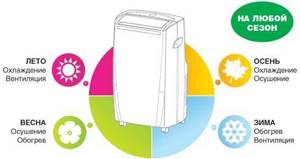
To heat the air, most monoblocks are equipped with a heating element - a built-in electric heater. The compressor works the other way around: cold air comes out into the pipe and hot air into the room. At the same time, electricity consumption increases significantly. Accordingly, operating efficiency decreases, and heating with a mobile air conditioner becomes expensive.
At the same time, there are three significant advantages:
- with this design you can serve areas up to 60 m²;
- heating with air conditioning in winter is possible at any outside temperature, since there is no external unit at all;
- A ceramic heating element can be installed in the mobile unit to heat the air.
A precision thermostat is installed in a monoblock with a heating mode, which will turn off the compressor when the device reaches the set temperature.
There are not many manufacturers producing high-quality monoblocks with heating functions. The most famous among them:
| Manufacturer | Models |
| BALLU | BPAM-07H |
| BORK | Y502 |
| DANTEX | RK-09PSM-R |
| ROLSEN | RAP-09CWAD |
| TIMBERK | AC TIM 07H P3 |
Why do you need a low temperature kit?
A winter set for a device may include sensors that, at low temperatures, give a command to the controller, ensuring slow operation of the fan of the external unit. This reduces the appearance of icing on the device. Also, a special compressor oil heater is included in the composition when the air conditioner is not working, which is maintained in a liquid state for a short time and makes it possible to quickly start the device. Also, a device that heats drainage pipelines will help get rid of condensate freezing and the formation of ice plugs.
How does an air conditioner work?
The operating principle of an air conditioner is based on transferring heat from indoors to outdoors. Haier air conditioners can operate in both cooling and heating modes.
Cooling
After turning on the air conditioner, gaseous refrigerant under low pressure enters the compressor, where it is compressed and heated to +70–90 o C, after which it enters the condenser. In the air heat exchanger of the outdoor unit, condensation of the refrigerant occurs - a transition from a gaseous state to a liquid one. This is accompanied by cooling of the refrigerant and release of heat. As the refrigerant passes through the capillary tube, it is throttled. In the evaporator heat exchanger, the reverse process occurs when the refrigerant changes from liquid to gaseous state. This releases cold and absorbs heat from the room.
Heating
When the air conditioner operates, heat must be removed from the condenser. In older models of domestic air conditioners, this heat is removed outside the room. More complex models allow you to use this heat to turn on the room heating mode.
Why an air conditioner may not work well
Poorly made or old air conditioners may leak refrigerant. Because of this, the performance of the air conditioner may decrease and the valve or evaporator may freeze.
If air and moisture enter the circuit, over time the compressor may fail and the capillary may become clogged with ice. To prevent this from happening, when installing the air conditioner, vacuum should be carried out using a special pump.
On a note!
New models of air conditioners are equipped with an automatic shutdown function when the set room temperature is reached. If such an air conditioner is constantly running, it may indicate an incorrect setting or malfunction.
If your remote-controlled air conditioner stops working, first of all, check the condition of the batteries. The question of why the air conditioner does not work and what to do may not be so difficult. In all other cases, when the air conditioner does not work well, you need to call a specialist.
Recommendations for working with the air conditioner
If the refrigerant in the evaporator does not have time to completely transform into a gaseous state, liquid enters the compressor inlet and it fails. This can happen both due to shortcomings of the air conditioner itself, and due to improper operation - first of all, when the air conditioner is turned on during frosts outside. Although many modern air conditioner models work for heating, they cannot replace the heating system. They are convenient to use in the off-season during a sudden cold snap, when the heating season is already over or has not yet begun.
On a note!
In order not to overload the air conditioner with constant operation at full power, you should close the windows and doors when it is on - after all, cold can be lost just as much as heat.
On hot sunny days, curtain the windows to avoid additional heating of the room. It is imperative to ventilate the room; this is a basic sanitary norm, but the air conditioner must be turned off.
Modern air conditioners always have filters on which dust and other small particles that pollute the air settle. Filters must be periodically washed and changed in accordance with the operating instructions. If this is not done, indoor air quality will decrease and the life of the air conditioner will be shortened.
You should always set the temperature to which you want to cool the room so that you are comfortable. Usually it is a little more than twenty degrees Celsius. If it's hot outside and you set the temperature to the minimum, it will be too much work for the air conditioner, and the heat exchanger may freeze and a refrigerant leak may occur. If desired, you can cool the room faster by increasing the fan speed.
Whatever air conditioning principle is chosen by the consumer, it must correspond to the goals and objectives set. Any type of air conditioner can be optimal for a particular type of consumer and his needs. But it is important to conduct professional consultations regarding the correct choice of air conditioner with a professional, which is easier to find from a certified dealer.
Summarize
From the information above, it becomes clear whether it is possible to turn on the air conditioner in winter, and also when it is not justified to do so. It is better not to turn on an air conditioning device equipped with a heating function in cold weather in this mode, and if used, then strictly to the temperatures specified in the equipment manual. This will prevent premature wear of the compressor and damage to the device.
A win-win option in houses that are planned to be heated in winter on their own would be to install an inverter model.
Before using the air conditioner for cooling in winter, you should carefully study the manufacturer's recommendations. But there will not be such strict restrictions if the device is equipped with a winter kit.
For information, we suggest watching a video on installing a winter kit on an air conditioner:
Which split systems are designed for heating in winter?
To ensure proper heating of an apartment or house, an air conditioner is not only equipped with a winter set - it requires special equipment. Such systems go beyond the middle price segment, but also work without problems at temperatures down to -15 °C. However, winters are often more severe - the temperature drops lower and lasts for 2-3 weeks. The solution is offered by brands such as Mitsubishi Electric Zubadan and Daikin FTXR, FVXG and FDX series.
On a note! The leaders in operating at extremely low temperatures are heat pumps from Daikin from the Altherma series. For active work, models of this line need both -10 °C and -25 °C. The manufacturer indicates very wide ranges for air-to-air and air-to-water units. This is a household analogue of advanced climate control systems in a car.
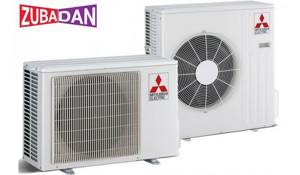
Today Daikin and Mitsubishi are catching up with the LG brand, offering new solutions. But such advanced equipment also has disadvantages, including:
- high price;
- continued risk of freezing of the outdoor unit;
- insufficient performance for heating a large apartment or house.
Advice! Manufacturers recommend combining split systems for heating with solid fuel boilers or other types of heating that do not consume electrical energy.
So, modern technologies make it possible to use climate control equipment for heating premises, but only within the temperatures specified by the manufacturer. Violation of the recommendations is fraught with the failure of the entire system. And if there is a need for heating or cooling rooms at extremely low temperatures, then you need to purchase specialized equipment rather than risk household split systems.



